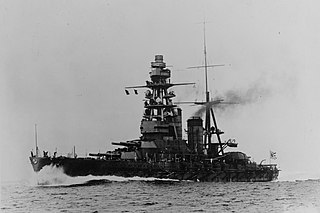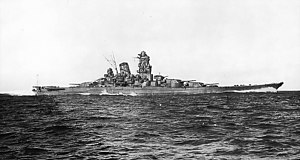
Fusō was the lead ship of the two Fusō-class dreadnought battleships built for the Imperial Japanese Navy. Launched in 1914 and commissioned in 1915, she initially patrolled off the coast of China, playing no part in World War I. In 1923, she assisted survivors of the Great Kantō earthquake.

Haruna was a warship of the Imperial Japanese Navy during World War I and World War II. Designed by the British naval engineer George Thurston, she was the fourth and last battlecruiser of the Kongō class, amongst the most heavily armed ships in any navy when built. Laid down in 1912 at the Kawasaki Shipyards in Kobe, Haruna was formally commissioned in 1915 on the same day as her sister ship, Kirishima. Haruna patrolled off the Chinese coast during World War I. During gunnery drills in 1920, an explosion destroyed one of her guns, damaged the gun turret, and killed seven men.

Hiei was a warship of the Imperial Japanese Navy during World War I and World War II. Designed by British naval architect George Thurston, she was the second launched of four Kongō-class battlecruisers, among the most heavily armed ships in any navy when built. Laid down in 1911 at the Yokosuka Naval Arsenal, Hiei was formally commissioned in 1914. She patrolled off the Chinese coast on several occasions during World War I, and helped with rescue efforts following the 1923 Great Kantō earthquake.

Hyūga was the second and last Ise-class battleship built for the Imperial Japanese Navy (IJN) during the 1910s. Although completed in 1918, she played no role in World War I. Hyūga supported Japanese forces in the early 1920s during the Siberian intervention in the Russian Civil War. In 1923, she assisted survivors of the Great Kantō earthquake. The ship was partially modernised in two stages in 1927–1928 and 1931–1932, during which her forward superstructure was rebuilt in the pagoda mast style. Hyūga was reconstructed in 1934–1936, improvements being made to her armour and propulsion machinery. Afterwards, she played a minor role in the Second Sino-Japanese War.

Shōji Nishimura was an admiral in the Imperial Japanese Navy during World War II.

Ise was the lead ship of her class of two dreadnought battleships built for the Imperial Japanese Navy (IJN) during the 1910s. Although completed in 1917, she played no role in World War I. Ise supported Japanese forces in the early 1920s during the Siberian Intervention in the Russian Civil War. In 1923, she assisted survivors of the Great Kantō earthquake. The ship was partially modernised in two stages in 1928–1929 and 1931–1932, during which her forward superstructure was rebuilt in the pagoda mast style. Ise was reconstructed in 1934–1937, with improvements to her armour and her propulsion machinery. Afterwards she played a minor role in the Second Sino-Japanese War.

Yamashiro was the second of two Fusō-class dreadnought battleships built for the Imperial Japanese Navy. Launched in 1915 and commissioned in 1917, she initially patrolled off the coast of China, playing no part in World War I. In 1923, she assisted survivors of the Great Kantō earthquake.

Kongō was a warship of the Imperial Japanese Navy during World War I and World War II. She was the first battlecruiser of the Kongō class, among the most heavily armed ships in any navy when built. Her designer was the British naval engineer George Thurston, and she was laid down in 1911 at Barrow-in-Furness in Britain by Vickers Shipbuilding Company. Kongō was the last Japanese capital ship constructed outside Japan. She was formally commissioned in 1913, and patrolled off the Chinese coast during World War I.

Kirishima was a warship of the Imperial Japanese Navy which saw service during World War I and World War II. Designed by British naval engineer George Thurston, she was the third launched of the four Kongō-class battlecruisers. Laid down in 1912 at the Mitsubishi Shipyards in Nagasaki, Kirishima was formally commissioned in 1915 on the same day as her sister ship, Haruna. Kirishima patrolled on occasion off the Chinese coast during World War I, and helped with rescue efforts following the 1923 Great Kantō earthquake.

Nagato was a super-dreadnought battleship built for the Imperial Japanese Navy (IJN). Completed in 1920 as the lead ship of her class, she carried supplies for the survivors of the Great Kantō earthquake in 1923. The ship was modernized in 1934–1936 with improvements to her armor and machinery and a rebuilt superstructure in the pagoda mast style. Nagato briefly participated in the Second Sino-Japanese War in 1937 and was the flagship of Admiral Isoroku Yamamoto during the attack on Pearl Harbor. She covered the withdrawal of the attacking ships and did not participate in the attack itself.

Mutsu was the second and last Nagato-class dreadnought battleship built for the Imperial Japanese Navy (IJN) at the end of World War I. In 1923 she carried supplies for the survivors of the Great Kantō earthquake. The ship was modernized in 1934–1936 with improvements to her armour and machinery, and a rebuilt superstructure in the pagoda mast style.

Yokosuka Naval Arsenal was one of four principal naval shipyards owned and operated by the Imperial Japanese Navy, and was located at Yokosuka, Kanagawa Prefecture on Tokyo Bay, south of Yokohama.

The Ise-class battleships were a pair of dreadnought battleships built for the Imperial Japanese Navy (IJN) during World War I. Both ships carried supplies for the survivors of the Great Kantō earthquake in 1923. They were modernized in 1934–1937 with improvements to their armour and machinery and a rebuilt superstructure in the pagoda mast style. Afterwards they played a minor role in the Second Sino-Japanese War.

The Kongō-class battlecruiser was a class of four battlecruisers built for the Imperial Japanese Navy (IJN) immediately before World War I. Designed by British naval architect George Thurston, the lead ship of the class, Kongō, was the last Japanese capital ship constructed outside Japan, by Vickers at Barrow-in-Furness. Her sister ships, Haruna, Kirishima and Hiei, were all completed in Japan.

The Nagato-class battleships were a pair of dreadnought battleships built for the Imperial Japanese Navy (IJN) towards the end of World War I, although they were not completed until after the war. The last of Japan's pre-Treaty capital ships, they were the first class to carry 41 cm (16.1 in) guns, the largest afloat at the time and the first bigger than 15 inches (381 mm). Nagato, the lead ship of the class, frequently served as a flagship. Both ships carried supplies for the survivors of the Great Kantō earthquake in 1923. They were modernized in 1933–1936 with improvements to their armor and machinery and a rebuilt superstructure in the pagoda mast style. Nagato and her sister ship Mutsu briefly participated in the Second Sino-Japanese War in 1937 and Nagato was the flagship of Admiral Isoroku Yamamoto during the attack on Pearl Harbor on 7 December 1941 that began the Pacific War.
The Eight-Eight Fleet Program was a Japanese naval strategy formulated for the development of the Imperial Japanese Navy in the first quarter of the 20th century, which stipulated that the navy should include eight first-class battleships and eight armoured cruisers or battlecruisers.

The Fusō-class battleships were a pair of dreadnought battleships built for the Imperial Japanese Navy (IJN) before World War I and completed during the war. Both patrolled briefly off the coast of China before being placed in reserve at the war's end. In 1922, Yamashiro became the first battleship in the IJN to successfully launch aircraft.

The Vickers 14-inch 45-calibre gun was designed and built by Vickers and initially installed on the battlecruiser Kongō which it was building for the Imperial Japanese Navy. Guns similar to this Vickers design were also later built in Japan to arm Kongō's sister ships and subsequent Japanese-constructed "super-dreadnoughts" which were all built in Japan. Japanese-built versions of the guns were designated 14-inch 41st Year Type, and from 1917 when the Navy went metric they were redesignated 36 cm 41st Year Type.

























